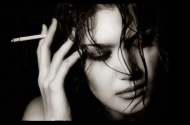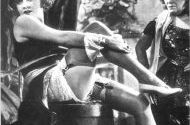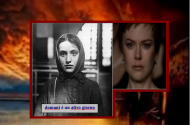When I saw the July 12, 2012 IAWA notice posted on their i-Italy blog: “IAWA Welcomes Kristine Gasbarre” the writer of How to love an American man: A True Story, I was curious about who she was and what she wrote. So I plugged the title into Amazon. What showed up was telling:
How to Love a Black Man by Ronn Elmore
How to Love a Black Woman... by Ronn Elmore
How To Love An American Man by Debra M. Rogers
How to Love an American Man: A True Story by Kristine Gasbarre
Clearly, “how to love” is a genre and I was curious about how an Italian American would treat the subject.
What is “Good Writing”?
“I don’t know what good fictional writing is. (I emphasize fictional because I do have opinions on what constitutes good non-fiction where Truth is a consideration). However, I don’t think ‘good fiction’ is limited to tragedy or high comedy – as my college literature teachers seemed to think. Melodrama is a legitimate literary art form and when done well it ranks with the best of the ‘high-brow’ stuff (e.g. Puzo’s novel The Godfather; many Sopranos episodes; etc. ).
Further, much “great literature”, my college professors conveniently ignored, is loaded with melodramatic devices such as deus ex machina events to keep the dead-in-the-water plot moving (e.g. the many ‘accidental’ street meetings in Dostoevsky’s Crime and Punishment)
Accordingly, my (frankly) distain for How to Love books is thematic and has nothing to do with their literary quality. Indeed, as I will discuss in the postscript below, Gasbarre’s book, in my judgment, is very well written. However, it’s a pathetically adolescent theme devoid of substantive Italian Americanita. Which raises the question, and main purpose of this note:
Why is the Italian American Writers Association promoting it?
‘Girly’ vs. ‘Womanly’ books
Gasbarre claims in the title of her book that it’s “a true story”. Interesting pharse, “true story”; does this mean it’s an autobiography? If so why not bill it as such. Frankly, I can’t help but wonder if it’s a fictionalized life story – albeit based on various true-life experiences. She placed a picture of her grandmother in the Introduction; presumably, her real life grandmother is the basis of the protagonist’s alter-ego grandmother character. But that may just mean that the real life grandmother was an inspiration and source of various anecdotal book events.
Could it be an editor or publisher suggested the sub-title “a True Story” to differentiate Gasbarre’s book from the other How to Love... books in the genre – break out of the pack...as it were?
More to the point, the book is what I would call a girly book, not to be confused with what I would call a womanly book. Writers like Tina De Rosa and Lisa Scottoline write womanly books. Both De Rosa, at the high literary end of the fictional spectrum, and Scottoline’s ‘dime gumshoe novels’ present Italian American women struggling with the “slings and arrows of outrageous fortune” and moral ambiguity in the context of an Italian American milieu.
Gasbarre presents a twenty-eight year old girl in an extended adolescence suffering from puppy love. More importantly, this girl isn’t remotely representative of an Italian American woman in an Italian American cultural setting.
“Krissy” (the protagonist): is not blue-collar; her grandfather founded a successful “international business...owned three houses, one on a lake”. She has a Masters degree; is professional writer; speaks fluent Italian learned in school (not spoken at home); worked as a nanny for Italian elites “on the Riviera and the Alps”. Her paternal great-grandparents are not southern-Italian (her mother is German American). Most significantly, in terms of the complete absence of Italian Americanita, Krissy suffers no material wants, anxiety or job pressures. She is totally free and has the resources to follow her every whim – your typical Long Island/New Jersey Italian American girl...eh!
Krissy’s only pain (apart from the death of her grandfather) is the inability to find: “a man down-to-earth enough to love everything about me.” WOW! Is that heavy or what?
IAWA curious promotion of the book
With the exception of a few clichéd references to Italian American culture (e.g. “tasting the sauce”) the book is largely devoid of anything Italian American. The vast majority of the narrative takes the form of reported dialogues and experiences with Kris and her grandmother and her boy friends. None of which convey any sense of Italian Americanita.
When compared to, what I would call, genuine Italian American writing such as De Rosa (Paper Fish), DeLillo (Underworld), everything Scottoline; yes even David Chase’s Sopranos (there is more Italian Americanita in fifteen minutes of The Sopranos than three hundred plus pages of How to Love...), Gasbarre’s book isn’t remotely an Italian American literary work – high or low brow.
I would be interested to know why IAWA thinks How to Love an American Man: A True Story meets the test of “Italian American” writing. Does an Italian last name, a few Italian clichés and a great-grandfather 'off the boat', constitute a necessary and sufficient condition to be called by the honorific title – Italian American writer?
///////////////
As a postscript, let me say:
It is not my place to criticize, based on my subjective literary values, Ms. Gasbarre’s choice of subject matter. Indeed, in terms of selling books, the How to Love... market seems to be where the money is. What she writes about is her business. However, apart from my distain for girly books, I think Gasbarre has mastered the craft of novel writing.
The book’s linear plot moves in a perfect cause and effect sequence complimented with effective use of flashback memories. The characters are well developed; the interaction between the characters is interesting and carry the plot forward to a cliff-hanging ending.
Gasbarre keeps the reader wondering and guessing right up to the last few pages. Sadly, to my mind, it’s not much of a cliff to hang on; the only thing to wonder and guess about is will he “pop the big question” or not? Middle school girls will love the suspense.
Personally, I think Gasbarre can write a great novel. She definitely has the writing skill. However, great art is the product of both skill and ideas. Many sculptors and fresco painters during the Renaissance were equal to Michelangelo in terms of skill. What differentiated Michelangelo as a great artist were the ideas he expressed in marble and paint.
If Gasbarre comes up with a great idea, she could write a great novel. If she wants to write a great Italian American novel she might consider Part 6 of Underworld. DeLillo left many great Little Italy characters and ideas hanging there. Characters like Bronzini, whom DeLillo flushed down the toilet, are perfect vehicles for writers to explore the real Italian Americanita.










I think you put yourself out
I think you put yourself out on a slippery slope when you try to define and pin down what is Italian American writing or any ethnic writing for that matter. Does an Italian American book have to contain certain images and symbols? Does it need to be explicit in its Italianita'? And in what ways? Is a writer whose parents came from Italy more of an Italian American writer than someone whose grandparents came from Italy? Or someone who is "part" Italian? Is someone who lives in an Italian American neighborhood more of an Italian American writer than someone who lives in Montana? There are some great Italian American novels out there. Personally, I think John Fante nailed it out of the park in the 1930s/1940s. His is not only some of the best Italian American writing, but also some of the best ethnic writing, and ultimately some of the best writing in English, period. My opinion, of course. He wrote from his life, from his experiences, and his talent and hard work allowed him to turn out books that have stood the test of time. Not every Italian American had his experiences; not every Italian American needs to tell that same story. People tell me that Lawrence Ferlinghetti was an Italian American writer, yet he never knew his Italian family and grew up completely divorced from anything Italian or Italian American. Is his work Italian American, given his background or given its subject matter? I won't venture to comment on Ms. Gasbarre or the inner workings of IAWA, but I do think what you call "real Italian Americanita" is up for discussion
on Ferlinghetti
I’m not sure how one would classify Lawrence Ferlinghetti, Italian American writer or not. I’m not sure it really matters. But do check out his poem “Old Italians Dying”. As one who remembers and dearly misses the “old Italians” I find this Ferlinghetti poem one of the most touching pieces of Italianitá out there.
If you read my comment
If you read my comment above, I'm NOT at all interested in classifying anyone or anything. I'll leave that to the scientists. My (rhetorical) questions are for the man who wrote this blog post. Personally, I think Italian American ethnicity exists. I think the Italian American experience exists. And if either of those things exist, then there most be something shared. It may not even be a lot, but something. Nevertheless, I don't subscribe to an essentialist view of Italian ethnicity or any other ethnicity for that matter. It diminishes the complexity of our community and its history. That say, I certainly don't agree with the blog poster's position as iterated in this post. My comment above is simply to express the diversity of IA experiences and the difficulty one runs into when putting someone in a box. So, either my remark wasn't clear, or the two people who commented on it (Ferlinghetti and Essentialist) didn't understand it.
Essentialism
The essentialist claims such as "real Italian Americanita" [sic] are frightening for the very fact that the slope is slippery, and we risk falling into a bias and bigotry that have no equal.
IAWA, curious indeed!
What is really curious is whom IAWA has not invited into their little club, given the many Italian-American writers, essayists, journalists, cultural critics, etc. in the area who have not been highlighted at / by IAWA. All these abbreviations—IAWA, NIAF, CCF, OSIA—they all seem to have their own little followings. Members? You decide. I've given up long ago.